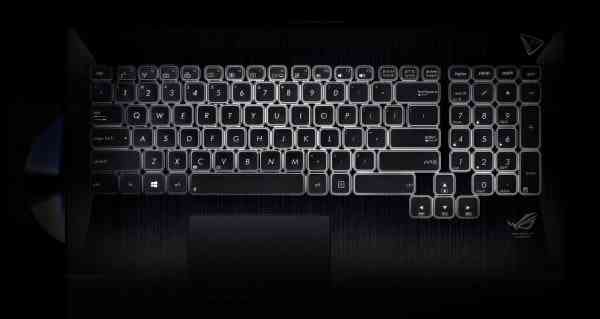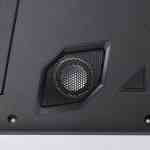A little under two months ago I got to review the ASUS G750JW gaming laptop and absolutely had nothing but good things to say about it. You can read that review HERE. The reason I mention this is because ASUS has a new higher spec model out that is very similar in most respects. It seems they may have listened to the few complaints I had about the G750JW too. Now we have the top of the Republic of Gamers (ROG) line of gaming laptops from ASUS in the new G750JH model. I gave the G750JW a 95 rating because other than the lack of an SSD and a terrible built in webcam it was a very solid gaming laptop that was able to run anything I threw at it and it was also a great buy for its price point. Now that the older brother, the G750JH, is here and considerably more expensive, does the price difference reflect the performance increase that you would come to expect from a top end gaming laptop?
Most people don’t consider laptops as real gaming machines, usually because they aren’t as fast as their desktop counterparts and because it’s usually very difficult to open them up and upgrade any components due to their form factor. ASUS understands this concern and has implemented solutions for both issues. Firstly, the hardware inside the ROG series is top notch (especially the G750JH) and you won’t have any issues running any games you throw at it. Secondly, they know that gamers like to upgrade or swap components out for newer ones, so the underbelly of the G750JH can easily come off so that you can reach the slots for the hard drives and RAM (just like the JW model).
ASUS is using the G750JH as their flagship gaming laptop, and many of the internal components have been upgraded when compared to the G750JW. It keeps the very quick Intel i7-4700HQ that the G750JW had for its CPU, but the RAM has been upgraded to 16GB (with slots open to expand up to 32GB if you desire), and they included a 256GB SSD. The lack of an SSD was my only real complaint with the JW model I reviewed previously. All of the other features that I mentioned in the past review return, but these were the biggest improvements that I noticed with the JH model.
PC gamers demand performance for their gaming habits, but the trade off is that when choosing a laptop for gaming they are usually incredibly expensive, heavy, bulky, and worst of all, they usually run very hot because of the components within. This is where the ASUS ROG line comes in, as they’ve found a great compromise of performance, power, heat, and aesthetics. Make no mistake about it though, the G750JH is a massive machine and weighs over 10lbs with the battery installed, but as I said, it’s a compromise considering the amount of power (and cooling which I’ll get into shortly) you get within. As a PC gamer I’m willing to take the trade-off given the performance contained within.
The G750JH is substantial in size. Considering the 17.3” 1920×1080 120Hz screen, full size keyboard with number pad, and the amazing cooling system that is unrivaled in my experience, it’s worth the heft and size on your desk. Sure, backpacking it around won’t be the easiest thing, but a machine like this is meant to be a desktop replacement, and while you can lug it around to other places, it has a lot of desktop PC performance. It’s a very sleek looking machine, even from afar, and even considering the size and weight; it never once felt uncomfortable on my lap for extended gaming and movie sessions.
Windows 8 is preloaded on the SSD drive and it is incredibly quick, not just performance wise, but boot up and shutdown wise as well. Multitasking isn’t an issue at all considering the power you have within the G750JH and I never once had start to stumble even when I had many software applications running at the same time. Gesture controls can be used with the touchpad and will take some time getting used to, but they eventually become second nature and I found myself using them without thinking about it at all.
As mentioned earlier, the CPU remains the same from the previous model with the Intel Core i7-4700HQ and it is quick enough to play any of the newest games you throw at it. It also keeps the laptop cooler with its heat reduction (though I’m sure the superb cooling system the ROG uses is a big help as well). This 8-core processor comes default-clocked at 2.4Ghz but it is easily overclockable up to 3.4Ghz if you desire.
What excited me about the newest JH model over the JW model is the video card. I had no problems running any games with the JW model, but with an even more powerful card contained within JH model, running games at max specs is definitely not a problem. The video card is now the NVIDIA GeForce GTX 780M 4GB (DX 11.1 compatible) and it will impress you with how powerful it is, even for being a mobile version. All the games I tested and played were running at maximum or ultra settings. Framerates were smooth, textures looked very sharp, and performance never once suffered no matter what settings I chose. The video card and screen is even capable of using the NVIDIA 3D Vision technology should you purchase the required corresponding hardware. This video card alone will justify the price point for many gaming enthusiasts and even though the G750JH is a notebook, the gaming fidelity definitely screams high-end desktop.
Almost any port you could need is also included in the G750JH as it has 4 USB 3.0 ports (two on each side for ease of access), a RJ45 LAN port when you want a wired connection, an HDMI port, a VGA port, a mini display port (now rebranded as Thunderbolt), and the standard microphone and headphone jacks as well. If you have devices that are Thunderbolt compatible you’ll have speeds that are double USB 3.0 at about 10Gbit/s. This port will be very handy if you want to move massive files in a short amount of time with a compatible device. The only port missing is an eSATA port, but it’s not a deal breaker by any means. You’ll also notice that all of the ports are located on the sides of the machine and none in the front or back. This is brilliant as the heat is vented out the back of the laptop and having ports and cords beside the vents are never a good idea. The whole back of the G750JH is actually reserved for the very large and stylish vents for the incredible cooling job it does (which I’ll get into shortly). The G750JH comes with your standard high speed LAN port and wireless capabilities of 802.11a/b/g/n, as well as Bluetooth 4.0 support. Oddly though, the older JW model had 802.11ac support for even faster wireless speeds if you had the router for it, but for some reason it’s been removed here.
While the JW model shipped with a single 1TB 5400RPM, the main concern I had with it was that it lacked a SSD drive for even better performance (the HDD was the only bottleneck the system had in the Windows Experience Index). It turns out that ASUS listened and now two drives are included in the G750JH; A 256GB SSD with Windows 8 preinstalled (the drive came partitioned into two different drives) and a 750GB 7200RPM HDD for all the storage you may need (also partitioned into two separate drives). With Windows 8 being installed on the SSD you get incredibly fast boot times and lightning quick load times with games installed on the drive as well. While some may like a slightly different setup, this is how I would have setup the hard drives myself, keeping Windows on its own partition with the rest being split up for game and storage.
The G750 series is actually inspired aesthetically by the F-22 Raptor stealth jet, and it shows. Sure it’s large and bulky, but it’s got aggressive lines and the dual rear exhausts gives is a gritty personality, which I really enjoy. With an ergonomic incline boasting a slim front and thicker back, it’s not all just all for looks; it’s also to help with the cooling as well. The outer shell is a unique rubberized matt lid with the inside being brushed aluminum, making for a unique contrast in looks and feel. My issue with the inner finish is that it’s what I call ‘Fingerprint Black’. It looks great when you open it for the first time, but once you start using it you’re going to see lots of fingerprints and smudges all over it no matter how clean your hands are and how diligent you are about wiping it down after every use. That being said, the keyboard feels fantastic as it’s full sized and the heat resistance is amazing even after hours and hours of gaming nonstop.
With some laptops you can tell if the screen has a cheap casing. As you try to open it looks like it’s slightly bending or you feel you need to be fragile with it to prevent damage; not with the G750JH. The screen feels solidly built and I was able to open the screen from its closed position anywhere on the lid without worrying about it bending or giving in any way. The large 17.3” (1920×1080) anti-glare LED display looks fantastic, sharp, and lacks any screen tearing or ghosting (thanks to the hardware). ASUS boasts the side-to-side viewing angle is 140 degrees, which I agree with, as you can watch the screen from almost any angle without any distortion. Even playing with directly sunlight on the screen, the anti-glare seemed to help eliminate much of that annoying reflection you can get when doing so. The only issue I had with the screen is the same issue I had in my JW review as well. The viewing angle side to side truly is impressive, but if you’re watching the screen from a lower angle with the screen pushed back further, it severely distorts the colors and is almost impossible to watch. It’s not how you would normally use it anyways, but worth noting none the less.
The G750JH boasts a full size keyboard that’s actually made out of a single piece of material to ensure its strength and durability. The keyboard is fully backlit and adjustable for brightness. It also has a full numeric keypad and isolated directional keys that make it very easy to game without hitting the wrong keys. This is the best full size keyboard you’ll find on a laptop in my opinion. The brightness on the backlit keys is perfect as it’s easy to see what buttons you’re pressing while not too bright to be a distraction to others in a dark room. My only suggestion would be to have dedicated media keys since there is so much extra room on the flat panel of the keyboard area (it uses Fn key combinations) and a choice of different colour or two for the backlight would have been a nice touch as well.
Just like the JW model the JH seems to come with the same webcam built in, which was my biggest disappointment in that review as well. It says it’s a full HD camera but every picture and video I took to test it had very poor results even with the highest settings (0.9MP). Sure, it’ll get the job done for Skype and basic chat, but considering the cost of the machine and how great every other component in the ROG machines are, it’s a shame this wasn’t upgraded as well. Again, it’s not a deal breaker by any means, but if you plan on using video Skype often, you’ll want a separate USB webcam as the built in one had incredibly poor performance unfortunately.
Whether you’re watching movies or playing games, the sound quality with the ROG series is superb. As I mentioned in my previous review, you might not even notice where the speakers are, and that’s the great job ASUS does at hiding the things you don’t necessarily need to see. The speakers are actually located in the bottom of the screen display lid between the hinges, so that when the screen is open the speakers are angled and projecting towards you and bouncing off the keyboard. On the bottom of the laptop you’ll even see the massive 3cm subwoofer (massive for a laptop that is) that also gives great feedback to your movies and games. I watched multiple Blu-ray movies and hours of games, and I was able to hear everything that I was supposed to and had zero distortion or static even with the volume fully set to 100.
Generally the rule of thumb is that the more powerful components you have the hotter they run, which is why heat is usually an issue for most laptops. Given the parts inside the ROG series (JW and JH) I was expecting to have a furnace on my lap the first time I got to try them. Sure, after reviewing the JW model I knew I had nothing to worry about with the newer JH model, but it’s still something I wondered about. Just like the JW model, the G750JH will stay cool on your lap no matter how many hours it’s sitting on it for. Usually with a poor ventilated laptop you need something on your lap to prevent your legs from burning after a certain amount of time; none of that here though. The cooling system in the G750 series never ceases to amaze me and even if you’re playing games for hours, heat will never cross your mind or distract you. Those massive exhausts I mentioned earlier do their job and do it well. The exhaust keeps the heat away from your lap and also keeps the keyboard and top area cool to the touch. Not once did I feel the G750JH get warm; the cooling is seriously that good. Usually keeping a laptop cool means that the fans will be running at full speed, which results in a noise factor as a trade off. Again, ASUS seems to have solved this problem as well, and even when the fans are audible it’s never a distraction. To be honest, sometime you’ll wonder if the fans are even on because of the lack of fan noise. ASUS’ cooling is easily the feather in their cap for their ROG series of gaming laptops.
Just like I did for my G750JW review, I don’t want to simply post framerates, specs, and a slew of charts and graphs to show the performance of the G750JH, but rather just give honest feedback on the games I played with the settings I ran them on. Charts and graphs to me don’t mean much when deciding on components or machines as much as honest feedback and usage does, which is what I’m striving for here.
For all of the games I played I instantly tried each game with every setting on the highest possible selection set to maximum or ultra. Every game I tried looked amazing and the framerates never dropped once. The main games I tried were Crysis 2, Guild Wars 2, Bioshock Infinite, Final Fantasy XIV, Half-Life 2, Skyrim, Battlefield 3, and more. I never once had to turn down any settings to compromise quality for performance. Every game ran smooth and it was actually quite impressive given the fidelity in some of these games, even with every setting cranked up to max.
At the end of the day the ASUS G750JH is huge, it’s bulky, and it’s heavy, but you know that going in and that’s this is a slight trade-off for having high-end desktop performance in a compact laptop. Battery life is what you would expect for such high-end components, ports are placed properly and in convenient places, and the cooling that the ROG series uses is second to none. Never once did the G750JH even feel warm to the touch, even after hours and hours of continuous use. Sure, the price point is high, but considering what you get component-wise within, and its world class cooling, make sure you look at the ASUS G750JH if you’re in the market for a top high end laptop that can run all of your games. I believe that ASUS is really onto something here with their ROG series of gaming laptops and the G750JH is their flagship model if you want the best of the best on the market today.





















